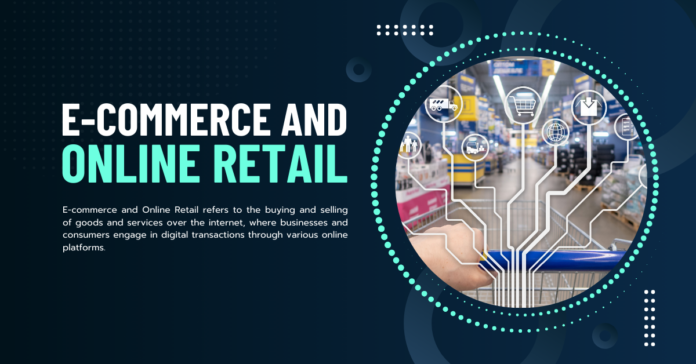Introduction
E-commerce has transformed the way consumers shop, making it easier than ever to purchase products and services from the comfort of their homes. As technology continues to evolve, so does the e-commerce landscape. This article explores the current trends that are shaping the future of e-commerce, from advancements in technology to changing consumer behaviors.
The Rise of Mobile Commerce
The Shift to Mobile Shopping
With the proliferation of smartphones and tablets, mobile commerce (or m-commerce) has become a dominant force in the e-commerce sector. Consumers increasingly prefer shopping on their mobile devices due to the convenience and accessibility they offer.
App-Driven Purchases
Retailers are investing in mobile apps to enhance the shopping experience. These apps often feature personalized recommendations, streamlined checkout processes, and exclusive promotions that encourage consumers to make purchases directly from their devices.
Mobile Payment Solutions
The rise of mobile wallets, such as Apple Pay and Google Wallet, has simplified the payment process. Consumers can make secure transactions with just a few taps, further driving the trend toward mobile shopping.
Personalization and Customer Experience
Tailored Shopping Experiences
Personalization is becoming a crucial component of e-commerce. Retailers are leveraging data analytics and artificial intelligence (AI) to create tailored shopping experiences based on individual preferences and behaviors.
Dynamic Pricing Strategies
E-commerce platforms are implementing dynamic pricing strategies that adjust prices based on demand, competition, and customer behavior. This approach allows retailers to optimize sales while providing competitive pricing for consumers.
Enhanced Customer Support
In the age of online shopping, customer support is more important than ever. E-commerce businesses are investing in chatbots and AI-driven customer service solutions to provide instant assistance and improve customer satisfaction.
The Growth of Social Commerce
Shopping Through Social Media
Social media platforms are increasingly becoming shopping destinations. With features like shoppable posts and in-app purchasing options, brands can engage with consumers directly on platforms like Instagram, Facebook, and Pinterest.
Influencer Marketing
Influencer marketing continues to gain traction in the e-commerce space. Brands collaborate with social media influencers to promote their products, leveraging the influencer’s audience to drive sales and build brand awareness.
User-Generated Content
User-generated content (UGC) plays a significant role in social commerce. Consumers trust reviews and recommendations from their peers, making UGC an effective tool for brands to showcase their products and build credibility.
Sustainability and Ethical Shopping
Eco-Friendly Products
As consumers become more environmentally conscious, e-commerce brands are prioritizing sustainability. Many retailers are offering eco-friendly products, using sustainable packaging, and adopting greener practices in their operations.
Transparency and Ethical Sourcing
Consumers are increasingly demanding transparency regarding the sourcing and production of products. Brands that openly share information about their supply chains and ethical practices are likely to gain consumer trust and loyalty.
Circular Economy Initiatives
The circular economy is gaining momentum in e-commerce. Brands are exploring strategies for recycling, reusing, and refurbishing products to reduce waste and promote sustainable consumption.
The Role of Artificial Intelligence and Automation
AI-Driven Recommendations
Artificial intelligence is revolutionizing the e-commerce landscape by enabling personalized product recommendations based on customer behavior. Retailers can analyze browsing history and purchase patterns to suggest items that align with individual preferences.
Automation in Fulfillment
E-commerce businesses are increasingly adopting automation in their fulfillment processes. Automated warehouses and robotics are streamlining order processing and reducing delivery times, enhancing overall efficiency.
Predictive Analytics
Predictive analytics allows retailers to anticipate consumer demand and optimize inventory management. By analyzing historical data and market trends, businesses can make informed decisions regarding stock levels and product offerings.
Payment Innovations
Cryptocurrency and Blockchain
Cryptocurrency is making waves in the e-commerce world, with some retailers beginning to accept digital currencies as payment. Blockchain technology also offers enhanced security and transparency in transactions, attracting tech-savvy consumers.
Buy Now, Pay Later (BNPL) Options
Buy Now, Pay Later services have gained popularity, allowing consumers to make purchases and pay in installments. This flexible payment option can increase conversion rates and boost sales for e-commerce businesses.
Subscription Models
Subscription-based models are becoming increasingly popular in e-commerce. Brands offer consumers the option to subscribe for regular deliveries of products, creating a predictable revenue stream while enhancing customer loyalty.
Conclusion
The future of e-commerce is bright, driven by technological advancements, changing consumer behaviors, and a growing focus on sustainability. As mobile commerce, personalization, social commerce, and payment innovations continue to shape the landscape, retailers must adapt to stay competitive. By embracing these trends and prioritizing the customer experience, businesses can thrive in the ever-evolving world of e-commerce.
